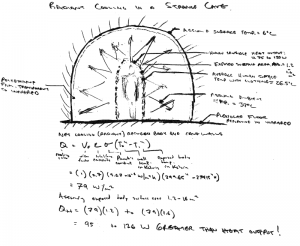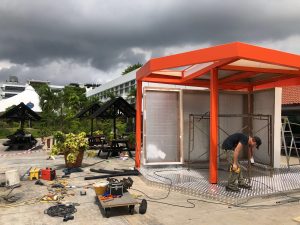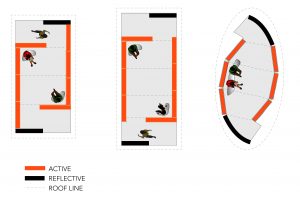Imagine entering a shaded outdoor space in the middle of a sunny day in Singapore. The ambient air around your body is hot – over 30 °C and 75% relative humidity. This outdoor space is not air-conditioned, nor is it ventilated by a fan or any other equipment. Yet, as you enter this space you begin to feel an unexpected sensation of cooling down. You touch the surfaces around you, and search for a source of cooling, but exposed surface temperatures feel little different than the hot ambient environment. What becomes even more bewildering is that, after a few minutes in this space, even though the air temperature is still not changing, you begin to actually feel properly cold…. outside… in Singapore…in the middle of the day.
Chances are that the experience above is difficult to imagine and hard to believe possible. This is the case because the heat transfer mode at play is one that seems intrinsically unfamiliar to us: radiant heat rejection from the human skin, otherwise known as, radiant cooling.
The research goal of the Cold Tube project is to explore new applications for selective low-cost polymers that universally enables radiant cooling in hot and humid environments without dehumidification and the risk of condensation. The project builds on an Singapore National Research Foundation (NRF) IntraCREATE Seed Grant project, named “Cold Tube”, referring to a new technology developed by the authors for providing radiant cooling in humid environments. Having begun in early 2018, the Cold Tube “1.0” project will demonstrate the functionality of this technology through the construction of a temporary outdoor pavilion in Singapore.
The Cold Tube concept allows the recursive relationship between design and radiant cooling to flourish, enabling radically new indoor and outdoor urban typologies and modalities, fundamentally based on materials engineering, thermodynamics, and design. The project will seek to investigate the potential implications of wider adoption of the technology in hot and humid climates, both through an expanded design-driven demonstration in a real-world scenario, and the development of calibrated predictive models of energy and comfort for integration with larger urban-scale heat island and Outdoor Thermal Comfort (OTC) models.
The project is a project of ETA Lab (UBC) in collaboration with the Singapore-ETH Centre, CHAOS Lab (Princeton University), the Center for Built Environment (UC Berkeley), and the Chair of Architecture and Building Systems (ETH Zurich).
More information on the project can be found here.




